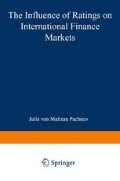Abstract
The Nineties have witnessed a boom of capital flows towards emerging markets that found an abrupt end with the Asian financial crisis in 1997/98. In general, this crisis has taken foreign investors by surprise resulting in a massive halt of foreign capital flows and a credit crunch in international and several domestic financial markets. During and after the Asian and Mexican financial crises investors complained about the inefficiency of rating agencies and blamed rating agencies for enforcing the dynamics of financial crises. The present study will thus focus on country risk, one of the principal elements that guide capital flows within international financial markets. It will present empirical analysis whether rating agencies stated their country risk evaluations timely and whether their risk evaluation was conform with those undertaken by financial markets. The first chapter will introduce the reader to international financial markets and their major developments during the Nineties. I will also review empirical and theoretical literature on financial crisis and their causes. This review, on the one hand, will acquaint the reader with the up-to-date discussion of causes for financial disruptions. On the other hand, it will become evident that theory has not yet found a unique risk model that predicts financial crises.
Access this chapter
Tax calculation will be finalised at checkout
Purchases are for personal use only
Preview
Unable to display preview. Download preview PDF.
References
Calvo, Leiderman and Reinhart (1993) and (1994); Chuhan, Claessen and Maminigi (1993); Dooley, Fernandez-Arias and Kletzer (1994); Fernandez-Arias (1994); Gosh and Ostry (1993); Schadler, Carkovic, Bennett and Khan (1993).
During 1870–1914 foreign capital financed about one third of domestic investment, while during the Nineties capital inflows finance about 10 percent of domestic investment in emerging markets. However, during the last century foreign direct investment accounted only for about 10 percent of capital flows. In contrast to this, up to 50 percent of capital inflows are due to foreign direct investment during the Nineties.
See also section 3.2.
Poignant-Eng ((1992), p. 30) also remarks that most rating agencies do not specify explicitly their rating methodology.
For more details please see section 2.4.2.1.
Domestic policies such as short-term economic mismanagement, long-term structural problems can lead to significant distortions and economic losses.
When a country is hit by disasters such as famine or droughts, public spending can explode tremendously.
Typical examples for external shocks are an increase in international interest rates, deterioration in a country’s terms of trade, or a weakening in worldwide consumption.
See also Heffernan (1986) for a similar approach.
This originates from the fact that financial markets refuse a defaulting country even those financial instruments that are used to insure trade business (e.g. bankers’ acceptances).
Niehans (1985) assumes in his cost-benefit model that sovereigns maximize the present value of the net capital transfers. The costs of default are exclusively restricted to the closing of the country’s credit lines. However, Niehans does not consider indirect economic cost due to the cut of credit lines.
Wyplosz (1998) puts forward that default cost might vary with the appearance of “good” and “bad” states of the world. A “bad” state of the world will alter the relative risk of borrowers and investors will ask for higher risk premiums increasing the total debt of borrowers. Hence, increasing interest rates might augment the benefit of default.
Bulow and Rogoff question the cost-benefit model by showing that “under fairly general conditions, lending to small countries must be supported by the direct sanctions available to creditors, and cannot be supported by a country’s reputation for repayment” (Bulow and Rogoff (1989b), p. 43). The authors assume that, when a government saves with foreign banks, it can earn the market rate of return on its savings, despite of its past defaults. The above-mentioned literature assumes that if a country defaults, it cannot save. See also Cole and Kehoe (1996) who derive the necessary conditions for Bulow and Rogoff’s model.
For some empirical studies that applied this model see e.g. Easton and Rockerbie (1999), Hajivassiliou (1985), Lee (1993); Nunnenkamp (1990); Nunnenkamp and Picht (1989).
Explanatory variables here are selected from the comparison of the present value of the utility function of consumption with and without the default (Lee (1991)).
See for instance Wyplosz (1986); Flood and Garber (1984); Agenor, Bhandari and Flood (1992); Blackburn and Sola (1993); Garber and Sevensson (1994); Flood and Marion (1994); Calvo (1997); Kaminsky, Lizondo and Reinhart (1998).
See Obstfeld (1986, 1994, 1996), Gerlach and Smets (1994), Velasco (1987), Calvo (1995).
This is caused by asymmetric information combined with implicit insurance (Rodrik (1998))
A similar approach was undertaken by Frankel and Rose (1996); Eichengreen, Rose and Wyplosz (1996); Meese and Rose (1996).
Folkerts-Landau et al. (1995) and Chang and Velasco (1998) find similar results.
Calvo and Mendoza (1996) put forward the same argument for the Tequila crisis of Mexico in 1994. They bring forward the hypothesis of a new form of balance-of-payments crisis. Countries with a fixed exchange rate become vulnerable, because large imbalances will emerge between stocks of liquid financial assets and gross reserves.
Rights and permissions
Copyright information
© 2000 Springer Fachmedien Wiesbaden
About this chapter
Cite this chapter
von Maltzan Pacheco, J. (2000). Capital Flows to Emerging Markets. In: The Influence of Ratings on International Finance Markets. Gabler Edition Wissenschaft. Deutscher Universitätsverlag, Wiesbaden. https://doi.org/10.1007/978-3-663-09040-3_1
Download citation
DOI: https://doi.org/10.1007/978-3-663-09040-3_1
Publisher Name: Deutscher Universitätsverlag, Wiesbaden
Print ISBN: 978-3-8244-7218-5
Online ISBN: 978-3-663-09040-3
eBook Packages: Springer Book Archive

